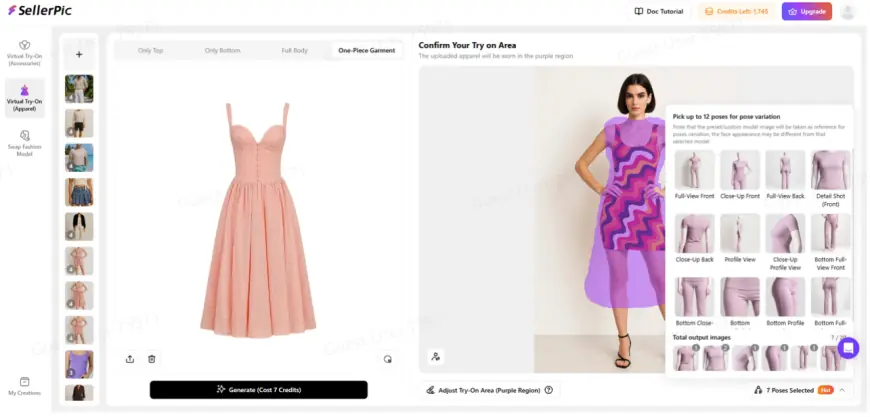Revolutionizing E-Commerce: The Impact of Virtual Try-On Technology on Retail Growth
E-commerce has transformed the way people shop, and virtual try-on technology is taking this transformation to the next level.

E-commerce has transformed the way people shop, and virtual try-on technology is taking this transformation to the next level. Online retail is no longer just about browsing through products and hoping they fit; it’s about providing consumers with an experience that mirrors in-store shopping. With AI and AR technologies, virtual try-on clothes have made it easier for customers to try on clothes digitally before making a purchase. This has significantly reduced the risk of dissatisfaction and returns, while also driving retail growth. One of the best examples of this technology is the Virtual try on apparels tool, which allows users to visualize how different clothing items will fit before purchasing. With the help of AI, it creates realistic simulations of clothing and makes the shopping process easier and more efficient.
In this article, we explore how virtual try-on technology is impacting retail growth, improving the online shopping experience, and providing value for both customers and retailers. Let's take a closer look at how these virtual fitting rooms are reshaping the future of fashion and online retail.
What is Virtual Try-On Technology?
The Basics of Virtual Try-On Clothes
Virtual try-on technology uses AI (Artificial Intelligence) and AR (Augmented Reality) to simulate how clothes would look on a customer’s body. Through the use of 3D modeling, AI analyzes a customer’s image or avatar and digitally places clothing on it to show how the garments would fit and look in real-time. Virtual fitting rooms provide a lifelike, interactive experience that helps customers visualize how an item will fit and feel before they make a purchase.
With virtual try-on apps, users can see how a variety of clothing items fit on their digital avatar or their own photo. These simulations ensure a more accurate and engaging experience for shoppers, making them feel as if they’re physically trying on the clothes, but from the comfort of their own home.
How Does Virtual Try-On Technology Work?
The process behind virtual try-on clothing is simple:
-
Upload an Image: The customer uploads their photo or uses the camera to scan their body shape.
-
AI-Generated Avatar: AI creates a virtual avatar that accurately represents the customer’s proportions and size.
-
Virtual Fitting Room Simulation: The customer can browse through clothing, and the virtual fitting room system will display how the clothes will look on the avatar in real-time.
This simple process eliminates the need for physical try-ons, making online shopping a more enjoyable experience.
How Virtual Try-On Technology Is Impacting Retail Growth
Increasing Conversion Rates
One of the most significant benefits of virtual try-on technology for e-commerce retailers is its ability to increase conversion rates. When customers can virtually try on clothes and see how they will fit, they are more likely to make a purchase. This is because virtual fitting rooms reduce the uncertainty that often accompanies online shopping, especially when it comes to choosing sizes.
By offering virtual try-ons, retailers can ensure that customers are more confident in their purchases, which directly impacts their sales growth. Additionally, as customers can try on multiple outfits with ease, they are more likely to add more items to their carts, leading to higher average order values.
Reducing Returns
A significant issue for many e-commerce businesses is high return rates due to size and fit issues. Virtual try-on clothes help solve this problem by allowing customers to see how items will fit them before they make a purchase. As a result, return rates are significantly reduced, saving retailers money on logistics and handling fees.
By enhancing the shopping experience with virtual try-ons, retailers not only reduce costs but also improve customer satisfaction, which is key to increasing brand loyalty.
Improving Customer Engagement and Experience
The ability to try on clothes virtually provides customers with an engaging and interactive shopping experience. Customers can experiment with different outfits, create looks, and see how clothing will fit them in different colors and styles. This level of personalization and interactivity keeps shoppers engaged longer and increases the chances of a sale.
Offering a virtual try-on option also allows retailers to gather valuable data about customers’ preferences and shopping behavior. By analyzing this data, retailers can tailor recommendations to individual customers, improving both the shopping experience and customer retention.
Second Anchor Placement:
Between 500 and 600 words into the content, AI Image to Video technology allows retailers to convert images of clothing items into videos for better presentation, increasing engagement and boosting conversion rates. Learn more about this exciting feature here.
Why Virtual Try-On Technology Is a Game-Changer for Retailers
Personalization and AI Integration
The integration of AI with virtual try-on technology is a game-changer for retailers looking to offer a more personalized experience. AI allows virtual fitting rooms to learn from customer interactions, understanding their preferences, sizing, and style choices. Over time, AI algorithms improve, making it possible to offer more accurate clothing recommendations.
For example, AI can recommend items based on the customer's body shape, preferred colors, and past purchases. This personalized shopping experience helps build stronger customer relationships and encourages repeat business, directly contributing to retail growth.
Offering New Revenue Streams
By integrating virtual try-on technology into their e-commerce platforms, retailers can tap into new revenue streams. For example, many brands are collaborating with tech companies that provide virtual try-on apps, creating partnerships that help increase exposure and sales. This technology opens up opportunities for retailers to engage with a broader audience and offer innovative shopping experiences that attract new customers.
Additionally, retailers can use virtual fitting rooms to cross-sell and upsell products by suggesting related accessories or styles that complement the chosen outfit. This enhances the average order value, which is crucial for long-term retail success.
The Future of Virtual Try-On Technology
Continued Advancements in AI and AR
As AI and AR technologies continue to advance, virtual try-on clothing will become even more realistic and accurate. Future innovations might include smarter body mapping, where virtual try-on systems can adapt to a wider range of body shapes and sizes. Additionally, AI algorithms may become even more sophisticated, offering better clothing recommendations and more accurate size predictions.
With continued investment in AI-powered virtual fitting rooms, retailers can expect to see an even greater impact on customer satisfaction and retail growth in the coming years.
The Metaverse and Virtual Fashion Shopping
The metaverse is rapidly gaining attention as a new frontier for digital shopping. As virtual worlds become more immersive, virtual try-on technology could play a significant role in the metaverse by allowing users to try on clothes in a fully digital environment. This shift could change how fashion retailers engage with customers, offering virtual shopping experiences that are as realistic and interactive as in-store shopping.
Conclusion
Virtual try-on clothes technology is transforming the e-commerce landscape, offering both retailers and customers a more interactive, personalized, and efficient shopping experience. By reducing return rates, increasing conversion rates, and improving customer engagement, this innovative technology is helping retailers achieve retail growth and create stronger relationships with their customers. As AI and AR technologies continue to advance, we can expect virtual try-ons to become an even more integral part of the online shopping experience, shaping the future of fashion and retail.
FAQs
What is virtual try-on technology?
Virtual try-on technology uses AI and AR to create digital simulations of how clothing will look on a customer’s body. This allows users to try on clothes virtually before purchasing them.
How does AI-powered virtual fitting rooms improve customer satisfaction?
AI-powered virtual fitting rooms offer personalized clothing recommendations, help reduce sizing issues, and provide a more immersive shopping experience, resulting in increased customer satisfaction.
How does virtual try-on technology help reduce return rates?
By allowing customers to see how clothes will fit before purchasing, virtual fitting rooms reduce the likelihood of returns due to poor fit or dissatisfaction.
Can I use virtual try-on technology on mobile devices?
Yes, most virtual try-on apps are optimized for mobile devices, allowing users to try on clothes directly from their smartphones.
Is virtual try-on technology available for all clothing types?
While most virtual try-on technology focuses on clothing like dresses, shirts, and pants, some platforms also offer virtual try-ons for accessories like shoes, jewelry, and eyewear.
What are the benefits of using AI-powered virtual fitting rooms?
AI-powered virtual fitting rooms offer personalization, accurate sizing, and realistic simulations, all of which contribute to a more engaging and satisfying shopping experience for customers.
How will AI and AR continue to impact virtual try-on technology?
As AI and AR technologies advance, virtual try-on experiences will become more accurate and immersive, offering better clothing simulations, smarter sizing recommendations, and more personalized shopping experiences.
Can retailers use virtual try-on technology for upselling and cross-selling?
Yes, virtual try-on technology allows retailers to suggest related products, accessories, and styles that complement the customer’s chosen outfit, helping increase average order value.
How does virtual try-on technology benefit retailers?
For retailers, virtual try-on technology boosts conversion rates, reduces return rates, and improves customer engagement, ultimately contributing to retail growth.
What does the future hold for virtual try-on technology?
In the future, virtual try-on technology will become more immersive, personalized, and integrated with the metaverse, changing the way consumers shop and interact with fashion brands.
What's Your Reaction?
 Like
0
Like
0
 Dislike
0
Dislike
0
 Love
0
Love
0
 Funny
0
Funny
0
 Angry
0
Angry
0
 Sad
0
Sad
0
 Wow
0
Wow
0



















































